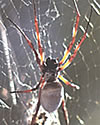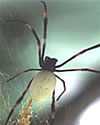Big Brown Spider With Fat Babies on Its Back
Orb Weaver Spiders This family of spiders is a very large i and includes over 2800 species in over 160 genera worldwide, making it the third largest family of spiders known behind the jumping spider family (Salticidae) and the second largest family unit of spiders called Linyphiidae unremarkably known as Canvass Weavers because of the shape of their webs.
The oldest known orb-weaving spider is 'Mesozygiella dunlopi', an extinct species of orb-weaving spider with specimens found in amber dating from the Lower Cretaceous period.
Orb Weaver Spider Characteristics
Because there are so many different species of Orb Weavers, they differ in color shape and size. The commonly seen Garden Orb Weavers are 2 to 3 centimetres in length for the female and 1.5 to 2 centimetres for the male in body length. Most are stout, reddish-dark-brown or gray spiders with a leaf-shaped pattern on their fat, roughly triangular abdomens, which besides have ii noticeable humps towards the front. Orb Weaver Spiders sometimes take a dorsal stripe which may be white or chocolate-brown edged with white.
Golden Orb Weavers are large spiders with a body length of two to 4 centimetres with silver-grey to plum coloured bodies and brown-blackness, often yellow banded legs. The males are tiny measuring only v millimetres and red-brownish to brown in colour. The main difference between the common Sydney species (Nephila plumipes) and Nephila edulis (which is more than common in inland regions) is the presence of a 'knob' on the front of the sternum (the heart shaped plate on the underside of the body between the legs) of Nephila plumipes.
Humped Orb Weavers or Silver Orb Weavers are easily recognised by their silvery body, with yellow or dark-green and blackness markings. They have long bodies and long limbs, with a trunk length of virtually one centimetre. The abdomen oftentimes has rounded 'shoulder' humps that requite these spiders their common name.
Orb Weaver Spider Gallery






Orb Weaver Spider Habitat and Webs
Orb-weaving spiders are three-clawed builders of flat webs with glutinous spiral capture silk. The building of a web is an engineering feat, begun when the spider floats a line on the wind to another surface. The spider secures the line and so drops another line from the center, producing a 'Y' shape. The rest of the web is so synthetic before the final sticky capture spiral is woven into place. Some species of Orb Weaver spiders remain in their webs day and night.
Some Orb Weaving spiders practise not build webs at all. Members of the genera Mastophora in the Americas, Cladomelea in Africa and Ordgarius in Australia produce sticky globules instead, which incorporate a pheromone analog (a chemical that triggers a natural behavioural response in some other member of the aforementioned species). The globule hangs from a silken thread dangled by the spider from its front end legs. The pheromone analog attracts male person moths of merely a few species. These get stuck on the globule and are reeled in to be eaten. Interestingly, both types of bolas spiders (unusual orb-weaver spiders that have given up spinning the typical spider web. Instead, they hunt past using a mucilaginous 'capture blob' of silk on the end of a line) are highly camouflaged and hard to locate.
Ane feature of the webs of some orb-weavers is the 'stabilimentum', a crisscross band of silk through the center of the web. It is found in a number of genera, but Argiope, which includes the common garden spider of Europe as well as the yellow and banded garden spiders of North America, is a prime number instance. The ring has been hypothesized to exist a lure for prey, a mark to warn birds abroad from the spider web and a camouflage for the spider when it sits in the centre of the web.
Humped Orb Weavers build modest flimsy, horizontal webs among shrubs and grasses or over h2o. They remain in their webs during the day and capture flies and other modest insects.
Most arachnid webs are vertical and the spiders normally hang with their head downward. A few webs, such equally those of orb-weaver in the genus Metepiera have the orb hidden inside a tangled space of spider web. Some Metepiera are semi-social and live in communal webs.
Orb Weaver Spider Nutrition
Orb Weaver spiders mainly each insects as their chief nutrition.
Orb Weaver Spider Venom
Orb Weavers are ordinarily reluctant to bite. Symptoms of an Orb Weaver bite is mild local hurting, numbness and swelling. Occasionally nausea and dizziness can occur after a bite. Humped Orb Weavers have very small fangs and they are timid and reluctant to bite.
Orb Weaver Spider Reproduction
The female person Garden Orb Weaver lays her eggs in belatedly summer to autumn. The eggs are encased in a fluffy silken cocoon and attached to leafage. The life span is about 12 months. They mature in summer, mate, lay their eggs and die in late summer-autumn. Males and females are similar in size. During fall, the spiderlings disperse by ballooning (floating on the cakewalk using small silk strands as 'balloons') and build their own tiny orb webs among vegetation.
In the Aureate Orb Weaver group, information technology is mutual for a number of tiny (6 millimetre) males to live around the edges of a females spider web, waiting for a mating opportunity. Later on mating, the female Gilt Orb Weaver wraps her unmarried egg sac in a mass of golden silk, which is and then hidden on foliage away from the spider web, bearded within a curled foliage or sprig of twigs.
Predators of orb weavers include several bird species and wasps of the family unit Sphecidae. The wasps land on the spider web, lure the spider to the perimetre by imitating a struggling insects vibrations and then carry the spider away to be paralysed and stored equally live food for their young.
pruittspecculp1971.blogspot.com
Source: https://animalcorner.org/animals/orb-weaver-spiders/
0 Response to "Big Brown Spider With Fat Babies on Its Back"
Post a Comment